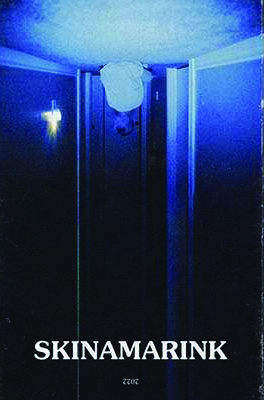Skinamarink: The best experimental horror movie since The Blair Witch Project

Most every kid experiences a specific kind of cognitive dissonance at some point in their childhood. Whether it be at a mall, an airport or simply on the street, the incomprehensible reality of losing track of your parents is a trauma familiar to many. In 2023’s Skinamarink, this confused and deeply-rooted fear is placed on stage: dressed up like a children’s doll with disorienting camera work and jarring analog production.
The movie places very little emphasis on character-building and more on what you don’t know about the cast. It stars two young children, Kaylee and her younger brother Kevin, who live at home with their parents. Their house is an endearingly drab cookie-cutter one, with carpeted floors and dark-stained cabinets. All this limited information is scattered throughout one of the movie’s strongest draws: its unconventional camera angles.
Almost immediately they stand out, strange and off-centered, almost wandering. Some of the most important scenes unfold as the viewers stare deeply into the grainy walls, trying to pick out even the slightest shadow that might slip out from a sliver of dimly-lit hallway. Other times they watch toys scattered across a carpet as the scene unfolds across the room and out of view.
Skinamarink capitalizes on the human fear of the unknown by keeping the viewer from seeing the terrifying events unfolding around them, hardly showing a single face throughout the entire runtime. There aren’t many faces to be shown anyway; Kevin and Kaylee’s parents disappear shortly after the film begins as things take an eerie turn.
Kaylee and Kevin, played by Dali Rose Tetreault and Lucas Paul, find themselves alone in their dark and quiet house. In a slow, half-asleep fashion, the kids go about their lives as normally as they are able. However, very quickly an eerie atmosphere begins to build as the viewer realizes something sinister is there with them.
Skinamarink is the epitome of built tension. The movie begins by building nerves early on with its unique style and then gradually adds to it with wince-inducing false alarms. Not too far in, when Kaylee runs into an inhuman version of her dad in her parents’ bedroom, he asks her to look under the bed. As Kaylee peaks beneath the bed into the dark, grainy under, viewers wait for the impending scare. When none is delivered, Kaylee looks back up at her dad. Still sitting atop the covers, he asks her to look one more time. At this point, something strange has happened. A discomfort has settled over the viewer yet again as several key opportunities for a cheap scare have passed. The viewer draws a simple conclusion: to brace themselves as Kaylee looks one more time. And yet, nothing happens and the scene continues, masterfully sustaining the scene’s tension.
Skinamarink is a degenerative disease that has eaten away at traditional horror scares, the real terror drawing from the deadly unknown of the disease itself. This movie is designed to throw the audience off, to make them question everything they thought they knew about horror, establishing rules written in another language.
When these rules are occasionally broken is when Skinamarink is most effective at scaring the viewer. Several times throughout the movie are surprising scares that are more akin to movies like Insidious and It, relying on pure, primal adrenaline-rush. Yet, by distributing these moments with great craftsmanship and deliberation, the scares become so much more. The viewer has sat through hours of Kaylee and Kevin’s miserable reality, trapped in a dark house with a malevolent being and no one to comfort or protect them. Every emotion, every sight, every sound, every touch has been experienced by the viewer, as though they were the kids themselves. The viewer finds themself constantly bracing at each movement and whisper, wondering, “Is this the time it finally happens?”–whatever “it” might be. Until finally, it really does happen, and it becomes a nightmare within a nightmare, suffocating and consuming.
Skinamarink is a movie best described as a visceral fever dream, and most importantly, every kid’s worst nightmare. For those looking to revisit the darkest moments of their childhood imagination that only the strange depraved-innocence of a child’s mind could produce, this movie is worth the watch.
Lincoln Wheeler (he/him) is a senior who loves playing hockey and guitar. He enjoys being a journalist because he wants to bring new perspectives and ideas to people.






